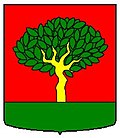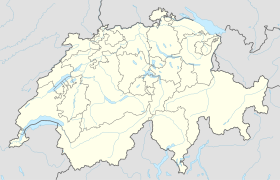Buchs LU
| LU is the abbreviation for the canton of Lucerne in Switzerland and is used to avoid confusion with other entries in the name Buch . |
| Buchs (LU) | ||
|---|---|---|
| State : |
|
|
| Canton : |
|
|
| Constituency : | Willisau | |
| Residential municipality : | Dagmersellen | |
| Postal code : | 6211 | |
| former BFS no. : | 1124 | |
| Coordinates : | 645 061 / 228060 | |
| Height : | 519 m above sea level M. | |
| Area : | 4.64 km² | |
| Residents: | 386 (December 31, 2004) | |
| Population density : | 83 inhabitants per km² | |
| Website: | www.dagmersellen.ch | |
| map | ||
|
|
||
Until December 31, 2005, Buchs was a political municipality in the Willisau district of the canton of Lucerne in Switzerland .
At the end of November 2004, the voters of Buchs decided to unite their community with Dagmersellen and Uffikon . The merger to form the new municipality of Dagmersellen was completed on January 1, 2006.
geography
The village is located on the west side of the upper part of the Hürntal between Sursee and Dagmersellen . It consists of a small town center around the St. Andreas chapel and various groups of houses and individual farmsteads. So is Müli (509 m. Above sea level. M.) 1 km northeast of the village. Other districts such as Schleif , Feld and Unter-Chätzigen are also far away from the village. The former municipal area has existed since the moor was drained to extract peat to a large extent (70.3%) from agricultural land. Forests and trees only cover 21.1% of the 464 hectares of the former municipal area; 7.3% are settlement areas.
Former neighboring communities
The neighboring communities of Buchs were Dagmersellen , Knutwil , Mauensee , Uffikon , Wauwil and Winikon .
population
The population grew rapidly from the end of the 18th to the middle of the 19th century. This was followed by a steady decline in population until 1990. Since then, the number of inhabitants has grown again significantly.
| Population development | |
|---|---|
| year | Residents |
| 1798 | 365 |
| 1850 | 583 |
| 1900 | 434 |
| 1990 | 330 |
| 2004 | 386 |
languages
The population speaks a highly Alemannic dialect. The main languages (2000 census) are German with 95.72%, Albanian with 3.21% and Romansh with 0.53%.
Religions - denominations
As in all municipalities in the canton of Lucerne, the population in earlier times consisted entirely of Roman Catholic Christians. Currently (as of 2000) 86.36% of the population are Roman Catholic. Religious minorities make up 6.68% of the Reformed Christians and 2.67% of the non-denominational.
origin
The vast majority of residents have a Swiss passport (95.72% without, 95.99% with dual citizens). The majority of the small group of foreign immigrants are Albanians from Kosovo. At the end of 2003 the proportion of foreigners was 2.3%.
Local council election 2004
In the last municipal council elections in the history of the independent municipality, there was no election. With a participation of 57.35%, the following people were elected to the (part-time) municipal council:
- Josef Wanner (CVP), mayor
- Josef Gabriel (CVP), mayor
- Anton Wey (FDP), social affairs
Elections to the Grand Council (Cantonal Parliament)
The last elections for the cantonal parliament were held in 2003. The CVP received 42.25% of the vote. Only the FDP with 36.02% and the SVP with 17.08% achieved a larger share of the vote. All other parties each received less than 2% of the vote.
economy
Of the 186 (as of 2000) employed, only a minority makes a living in their own village. At that time there were 124 commuters who mostly worked in other places in the region (Sursee, Dagmersellen etc.). In 2001 agriculture employed 62.8% (in 29 businesses), industry and trade 12.4% and service companies 24.8% of the 113 people working in the village.
tourism
Tourism plays no role (just passing hikers).
traffic
The A2 passes east of Buchs. The next motorway connections in Dagmersellen and Sursee are therefore only a few kilometers away. Public transport connects the village during the day with the Sursee-Buchs-Uffikon post bus line. During the night there is an on-call bus ( called Publicar ).
history
The Buchs area must have been settled early on. Because in the Obermoos district, flint arrowheads and stone axes were excavated. In historical times a Roman road ran through the valley. It was therefore hardly surprising that the remains of a Roman manor were found during excavations in 1983 and 1984 on the occasion of the restoration of the St. Andreas chapel . A medieval burial ground from the 9th and 10th centuries was found above these remains. And above that, the remains of a castle (consisting of a keep, a residential wing and a surrounding wall) were brought to light. However, the builders and owners of the castle are unknown. Part of the walls form the foundation of the chapel.
The place is first mentioned in 1180 under the name Buchis (an uncertain source). In 1285, bush is mentioned by name in connection with a land sale by Niklaus von Fischbach to the St. Urban monastery . The area belonged to the Habsburg rulership as early as 1303 . The higher jurisdiction fell to Lucerne in 1407, the lower from 1460 to 1579 to the Zofingen monastery. The latter sold his rights to the city of Lucerne.
Buchs belonged to the Willisau Bailiwick early on, which later became the Willisau Office. There have been no more floods since the Hürnbach correction in 1822. There were only major catastrophes in 1819 with a major fire and in 1942 with a major storm. The municipality became part of the municipality of Dagmersellen on January 1, 2006 as part of the "municipality mergers" project of the canton of Lucerne together with Uffikon.
schools
In the summer of 2010, the entrance level was introduced in Buchs. The children from kindergarten to second grade (from Buchs and Uffikon) are taught together. Two departments are run. The 3rd – 6th Class visit the children in Uffikon. From the 7th grade onwards, students attend classes in Dagmersellen.
Attractions
The St. Andreas chapel is worth seeing . It was first mentioned in the late 14th century. In 1479 this first building was replaced. Today's chapel dates from 1608 and is a mixture of late Gothic and early baroque styles. In the chapel there is a medieval painting depicting a pelican. A special feature of the chapel is the existence of two high altars. The high altar St. Andreas and the pilgrimage altar St. Notburga on one of the sides. In a monstrance of the main altar there are said to be fragments of the Holy Cross.
A sports field in the village center is also suitable for lingering, consisting of a lawn, a tar field with markings for various types of sport and a tartan track including a sand basin for long jump. Events that contribute to village life in the community take place here on a regular basis.
literature
- André Meyer: St. Andreas Chapel in Buchs. (Swiss Art Guide, Volume 614). Ed. Society for Swiss Art History GSK. Bern 1997, ISBN 3-85782-614-2 .
- G. Meyer: Buchs. (published 1997).
- The art monuments of Switzerland. Canton lucerne. Volume VI. Birkhäuser Verlag, Basel 1963.
Web links
- August Bickel: Buchs (LU). In: Historical Lexicon of Switzerland .


